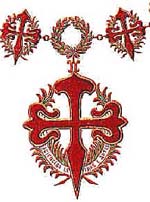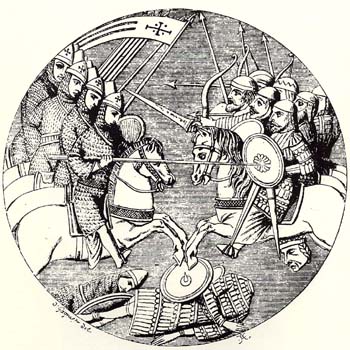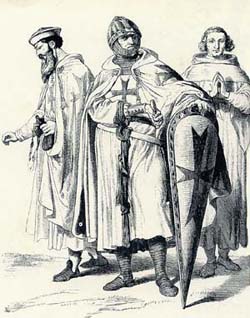 |
The Saint of the Day
Blessed Pedro Rodrigues, June 11
Prof. Plinio Corrêa de Oliveira
Biographical selection:
Blessed Pedro Rodrigues, martyr, 12th-century, was a commander of the military Order of Saint James of the Sword. On this day we also commemorate the martyrdom of blessed Pedro Vale, Domingos Vaz, Alvaro Garcia, Stephen Vasques, and Valerio Doria, all Portuguese knights of the same Order.

Commander insignia for the Order of St. James
|
Lord Pelayo Correia, Grand Master of the Order of St. James of the Sword, had taken numerous important sites from the Moors in the Algarve province of Portugal. Since harvest time had arrived, the Arabs requested a four-month break to dedicate themselves to bringing in the crops. It was granted.
During this time, the Grand Master gave permission to Military Commander Pedro Rodrigues and another five knights to leave the camp quarters to hunt. During a chase, they came up on Antas, near the city of Tavira. They were spotted by a large group of Moors who charged against them like wild wolves. Realizing the danger, the Catholic knights sent a messenger to the Grand Master and prepared to defend themselves.
The Grand Master arrived as soon as he could, but it was already too late. The six knights of his Order were lying dead on the ground among an enormous number of Arabs they had slain. Lord Pelayo was indignant since the Moors had broken their given word. On the horizon he caught sight of Arab knights who had fled on his arrival, and he chased them to the city of Tavira. There he attacked and conquered the city.

The outnumbered knights valiantly defend their party from the unexpected attack by the Moors
|
The first concern of the victor was to purify the main mosque of the city and transform it to a Catholic church so that the Holy Mysteries could be celebrated in thanksgiving for the conquest. That church was dedicated to St. Mary, Queen of the Angels, with a special side altar to St. Barnabas, on whose feast the victory was achieved. Behind this altar the mortal remains of the Catholic heroes were placed. Since they had died fighting for the Faith, the faithful honored them as martyrs.
Many years later, Alphonse VIII, King of Castile, was encircling Tavira in a siege. One Saturday morning he was walking around the walls studying the best place to assault the city, when he noticed six gigantic knights wearing the habit and carrying the banner of the Order of St. James hovering in the air over the Church of St. Mary.
Astonished by the vision, he went to the Monastery of St. Francis, outside the city walls, to ask what this could mean. The monk who guarded the monastery gates told the Monarch:
“Have no doubt! They are the knights of St. James killed by the Moors in an ambush in those days when Lord Pelayo took Tavira. As long as their relics remain in the Church of St. Mary, they protect the city against its enemies.”
Soon afterward, moved by respect for the Blessed Knights, Alphonse VIII ordered his army to leave the city and return to Castile.
Comments of Prof. Plinio:
This is a very beautiful story, which to be well understood needs some explanations.

Religious military orders: Above, the Templar Knights; below, the Teutonic Knights
 |
I don’t know how many of you have a clear idea about what a religious military order was. It was a religious order of the time much like the Franciscans, Dominicans, or Benedictines. The religious members of a military order had a similar life – they had the three vows, they lived in a monastery, they were subject to a rule, and they had to obey a superior, like the other religious orders.
But they had a special characteristic: their mission was to wage war for the cause of the Holy Church. Therefore, they used to fight in the Crusades, attack the Moors wherever they were a threat against the Catholic cause, and fight the barbarians as well as other enemies of the Church. The religious military orders produced great warriors. The Order of St. James of the Sword was one of these orders. It was dedicated principally to fight the Moors on the Iberian Peninsula. The members of the Order, therefore, waged war against those Arabs who had invaded Spain and Portugal centuries before.
With these presuppositions, let us return to the narration.
Six of those knights went to hunt with the permission of the superior. They came too near the Moors, who violated the truce and attacked them. The Catholic knights sent an alert to their superior, but they did not step back; they sold their own lives at a high price and died. When the Grand Master arrived at the scene, he realized the bravery of the knights by the number of Moors they had killed, their cadavers also laying on the ground. The Grand Master pursued the enemies, conquered the city, and transformed the mosque into a Catholic church.
When they invaded Spain, the Moors changed the Catholic churches into mosques. When the Catholics re-conquered them, they made them Catholic again. At times, however, certain mosques were never Catholic first, like the most beautiful Cathedral of Cordoba that was constructed as a mosque and is a masterpiece of Arab architecture.
The Catholics, then, would purify the mosque and make it a church. Canon Law used to specify that when a church had been in the hands of pagans or heretics, it should be purified in accordance with many specific rules. This needed to be done because when heretics and pagans use a building to make their impure ceremonies of worship, it draws together all kinds of devils. Therefore, the building must be purified. A purification like this - what an anti-ecumenical act! So, the church was purified and the martyrs were buried there.
Many years afterward, a King of Castile, Alphonse VIII, was encircling the city, and the six knights appeared in the sky. He went to ask a monk what this meant, and he learned that they were the protectors of the city. He withdrew from the environs.
You are seeing the importance of the relics of those martyrs in the city. They constituted a kind of supernatural wall of protection for it. The Castilian King drew back from the city. You can see how worthwhile it is to have relics. It is very important for us to be close to the bodies – or a part of the bodies – of those who are in Heaven.
The relics deserve a true veneration. If some of you have a relic or many relics, you should treat them with respect. Here is some advice:
- At the least kiss them when you wake up in the morning and when you go to sleep at night;
- Keep them in a box on the side table by your bed;
- If you always carry one or two with you, keep them in a separate place in your clothes with your rosary. Do not put them together with papers, receipts, and aspirins for instance. It is not advisable to keep them in the same place with money either. The money, in a certain sense, symbolizes the opposite of the relics: it symbolizes the pleasures of this earth, while the relics stand for the life of sacrifice needed to reach Heaven. Keep one pocket for your money, and another for your relics.
These are just some suggestions. Do not feel obliged to follow them.


  | | Prof. Plinio Corrêa de Oliveira | |
The Saint of the Day features highlights from the lives of saints based on comments made by the late Prof. Plinio Corrêa de Oliveira. Following the example of St. John Bosco who used to make similar talks for the boys of his College, each evening it was Prof. Plinio’s custom to make a short commentary on the lives of the next day’s saint in a meeting for youth in order to encourage them in the practice of virtue and love for the Catholic Church. TIA thought that its readers could profit from these valuable commentaries.
The texts of both the biographical data and the comments come from personal notes taken by Atila S. Guimarães from 1964 to 1995. Given the fact that the source is a personal notebook, it is possible that at times the biographic notes transcribed here will not rigorously follow the original text read by Prof. Plinio. The commentaries have also been adapted and translated for TIA’s site.
|
Saint of the Day | Home | Books | CDs | Search | Contact Us | Donate

© 2002- Tradition in Action, Inc. All Rights Reserved
|
 |
|